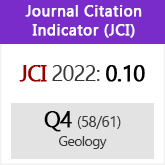Implications of DFN Model Selection in Open Pit Bench Stability Analyses
DOI:
https://doi.org/10.21701/bolgeomin.131.3.004Keywords:
bench face stability, Discrete Fracture Network (DFN), Limit Equilibrium Analysis (LEA)Abstract
A coupled Discrete Fracture Network (DFN) – Limit Equilibrium Analysis (LEA) approach to the design of bench face slopes in open pit mines has significant advantages over conventional analyses. The reliability of this approach is directly related to the quality of the input data and the ability for the generated DFN to adequately capture the characteristics of the rock mass. Different DFN model generators have specific input requirements and inherent assumptions. This paper addresses the critical issue of selecting an appropriate DFN model. Through a worked example, it illustrates the implications of selecting a series of different DFN models and generators on the stability analyses, and interpretation of the results. This is shown to have significant impact on the design of open pit slopes.
Downloads
References
Baecher G B, Lanney N A, Einstein H H, 1978. Statistical description of rock properties and sampling. Proceedings of the 18th U.S. Symposium on Rock Mechanics, 5C1-8.
Dershowitz, W.S. and Herda H.H. 1992. Interpretation of fracture spacing and intensity. Proceedings of the 33rd U.S. Rock Mech. Symposium, Santa Fe, New Mexico. pp. 757-766.
Dershowitz, W.S. and Carvalho, J. 1996. Key-block tunnel stability analysis using realistic fracture patterns. North American Rock Mechanics Symposium, Montreal. (Aubertin et al. eds), pp. 1747-1751.
Dershowitz W S, Lee G, Geier J, Foxford T, LaPointe P, Thomas A, 1998. FracMan Version2.6 Interactive Discrete Feature data Analysis, Geometric Modeling, and Exploration Simulation, user documentation, Report 923-1089, Golder Associates Inc, Seattle, Washington.
Elmo, D., Liu, Y. and Rogers, S. 2014. Principles of discrete fracture network modelling for geotechnical applications. International Discrete Fracture Engineering Conference, DFNE 2014 - 238.
Elmouttie, M.K. and Poropat, G.V. 2011. Uncertainty Propagation in Structural Modeling Slope Stability 2011: International Symposium on Rock Slope Stability in Open Pit Mining and Civil Engineering, Vancouver, Canada.
Fisher, N.I., Lewis, T. and Embleton, B.J.J. 1993. Statistical analysis of spherical data. Paperback ed. 1993: Cambridge University Press.
Geier, J.E., K. Lee, and. W.S. Dershowitz, 1988. Field Validation of Conceptual Models for Fracture Geometry," paper H12A-ll presented at the American Geophysical Union 1988 Fall Meeting.
Guest, A. and J. Read 2009. Geotechnical Model. Chapter 7 in Guidelines for Open Pit slope Design. CRC Press, pp. 201-211.
Grenon, M., Landry, A., Hadjigeorgiou J. and Lajoie, P.J. 2017. Discrete Fracture Network based drift stability at the Éléonore mine. Mining Technology: Transactions of the Institutions of Mining and Metallurgy: Section A, Vol 126, No 1, pp. 22-33. https://doi.org/10.1080/14749009.2016.1199296
Grenon, M and Hadjigeorgiou, J. 2018. Fracture-SG: a fracture system generator software package, version 2.25. Quebec City, Canada.
Grenon, M. and Hadjigeorgiou, J. 2012. Applications of Fracture System Models (FSM) in mining and civil rock engineering design. International Journal of Mining, Reclamation and Environment, 26 (1), 55-73. https://doi.org/10.1080/17480930.2011.639190
Grenon, M. and Hadjigeorgiou, J. 2008. Design of road cuts susceptible to wedge failures using fracture system modelling. Engineering Geology, 96, 78-93. https://doi.org/10.1016/j.enggeo.2007.10.002
Grenon, M. and Hadjigeorgiou, J. 2018. Fracture-SL. A Fracture System Based Rock Slope Wedge Stability Analysis Software Package, Version 1.41. Quebec City, Canada.
Hadjigeorgiou, J. 2012. Where do the data come from? Mining Technology, 121 (4), 236-247. Jing, L. (2003). A review of techniques, advances and outstanding issues in numerical modelling for rock mechanics and rock engineering. International Journal of Rock Mechanics and Mining Sciences, 40(3), 283-353. https://doi.org/10.1016/S1365-1609(03)00013-3
Mathis, J.I. 2016. Structural domain determination - practicality and pitfalls. APSSIM 2016, Brisbane, Australia, pp.203-212. https://doi.org/10.36487/ACG_rep/1604_09_Mathis
Mathis, J.I. 2014. Bench Face Angle Distributions - The Requirement for DFN Analysis. International Discrete Fracture Engineering Conference DFNE 2014 - 105.
Staub, I., Fredriksson, A. and Outters, N. 2002. Strategy for a rock mechanics site descriptive model development and testing of the theoretical approach, SKB report, no. R-02-02, prepared for Golder Associates AB, Stockholm.
Veneziano D, 1978. Probabilistic model of joints in rock. Unpublished manuscript, Massachusetts Institute of Technology, Cambridge, Massachusetts.
Zhang, L. and Einstein, H.H. 1998. Estimating the mean trace length of rock discontinuities, Rock Mechanics and Rock Engineering, 31(4), 217-235. https://doi.org/10.1007/s006030050022
Downloads
Published
How to Cite
Issue
Section
License
Copyright (c) 2024 Consejo Superior de Investigaciones Científicas (CSIC)

This work is licensed under a Creative Commons Attribution 4.0 International License.
© CSIC. Manuscripts published in both the printed and online versions of this Journal are the property of Consejo Superior de Investigaciones Científicas, and quoting this source is a requirement for any partial or full reproduction.
All contents of this electronic edition, except where otherwise noted, are distributed under a “Creative Commons Attribution 4.0 International” (CC BY 4.0) License. You may read here the basic information and the legal text of the license. The indication of the CC BY 4.0 License must be expressly stated in this way when necessary.
Self-archiving in repositories, personal webpages or similar, of any version other than the published by the Editor, is not allowed.
















